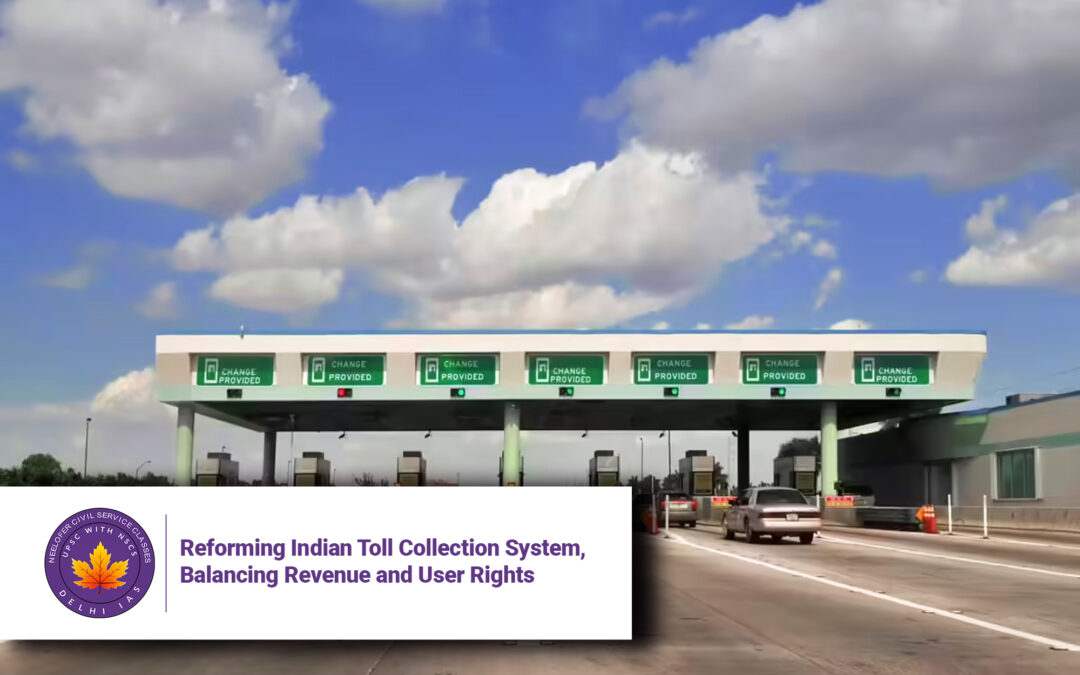Reforming Indian Toll Collection System, Balancing Revenue and User Rights
Introduction
The Public Accounts Committee (PAC) of Parliament’s recent report on toll collection practices has brought to light critical inefficiencies in India’s highway taxation system. With recommendations ranging from ending “perpetual tolling” to improving FASTag implementation, this report could herald a new era of fairer and more transparent road taxation. This article examines:
-
Key flaws in India’s current toll collection system
-
PAC’s major recommendations for reform
-
Global best practices in road pricing
-
The FASTag revolution and its unfinished agenda
-
5 Key Q&A on toll reforms
By analyzing these aspects, we assess whether India’s toll system serves public interest or private profits.
The Current Toll System: Flaws and Criticisms
1. The Problem of Perpetual Tolling
-
Toll collection continues indefinitely on many highways even after full cost recovery
-
No sunset clause for most projects despite original 10-15 year recovery periods
-
Example: Delhi-Gurgaon Expressway continues tolling 15+ years after construction
2. Opaque Toll Pricing Mechanism
-
Annual 3% automatic increase plus WPI adjustment
-
No relation to actual maintenance costs or road quality
-
No independent audit of operator expenses
3. Inequitable Burden on Users
-
Commercial vehicles bear disproportionate burden
-
No differential pricing for essential vs luxury transport
-
Poor service quality during construction periods
4. FASTag Implementation Gaps
| Issue | Impact |
|---|---|
| Malfunctioning scanners | Causes congestion at plazas |
| No on-site top-up facilities | Forces cash payments |
| Lack of interoperability | Inconvenience for multi-state travelers |
PAC’s Key Recommendations
1. Ending Perpetual Tolling
-
Mandate toll cessation after full cost recovery
-
Any extension requires independent approval
-
Must justify continued collection with road upgrades
2. Establishing Toll Regulatory Authority
-
Independent body to oversee:
-
Toll rate determination
-
Cost auditing
-
Service quality monitoring
-
-
Modeled after electricity/gas regulators
3. Reforming Toll Pricing
-
Base rates on actual maintenance costs
-
Implement dynamic pricing (peak/off-peak)
-
Introduce distance-based tolling
4. Improving FASTag System
-
Mandate functional scanners at all plazas
-
Install on-site FASTag service centers
-
Develop interoperable national system
Global Best Practices
1. Singapore’s ERP System
-
Electronic road pricing based on:
-
Traffic congestion
-
Time of day
-
Vehicle type
-
-
No physical toll plazas
2. European Distance-Based Tolling
-
Heavy vehicles pay per km traveled
-
Rates vary by emission class
-
Automated via onboard units
3. US State Models
-
Some states ban tolls after cost recovery
-
Others use toll revenue for new projects
-
Transparent revenue allocation
5 Key Q&A on Toll Reforms
Q1: Why is perpetual tolling problematic?
A: It transforms temporary cost-recovery mechanism into permanent taxation without legislative approval or public benefit justification.
Q2: How would a Toll Regulatory Authority help?
A: It would bring transparency to toll pricing, prevent operator profiteering, and ensure fair returns on public-private partnerships.
Q3: What’s wrong with current FASTag implementation?
A: Despite 98% penetration, system failures force manual interventions, defeating the purpose of contactless tolling and causing delays.
Q4: How could distance-based tolling work in India?
A: Using GPS/onboard units, vehicles would pay only for distance traveled on tolled sections, making pricing more equitable.
Q5: What happens to BOT operators if tolling stops after cost recovery?
A: Contracts need restructuring – either shorter concession periods or government buyback options at cost-recovery point.
The Road Ahead
Implementing PAC’s recommendations requires:
-
Legislative Action
-
Amend National Highways Act, 1956
-
Define cost-recovery sunset clauses
-
-
Technological Upgrades
-
Next-gen FASTag system
-
AI-based traffic monitoring
-
-
Institutional Reforms
-
Create Toll Regulatory Authority
-
Standardize contract frameworks
-
-
User-Centric Approach
-
Grievance redressal mechanisms
-
Real-time quality monitoring
-
Conclusion
India’s toll collection system stands at crossroads. The PAC report provides a blueprint to transform it from an opaque, perpetual revenue stream into a transparent, user-focused infrastructure funding mechanism. By implementing these reforms, India can achieve the delicate balance between maintaining world-class highways and protecting citizens from unfair taxation. The time has come to ensure tolls serve their original purpose – financing better roads, not endless profits.







